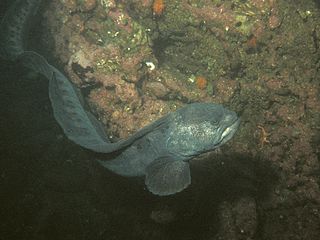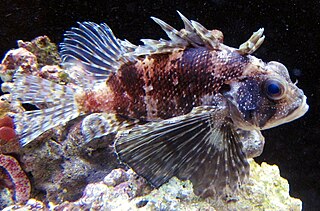
The painted greenling is a species of marine ray-finned fish belonging to the family Zaniolepididae, which includes this species and the combfishes. It is endemic to the northeast Pacific Ocean. It is the only species in the genus Oxylebius.

The rock greenling is a species of marine ray-finned fish belonging to the family Hexagrammidae, the greenlings. It is sometimes known as fringed greenling and erroneously as the red rock trout.

The wolf eel is a species of marine ray-finned fish belonging to the family Anarhichadidae, the wolf fishes. It is found in the North Pacific Ocean. Despite its common name and resemblance, it is not a true eel. It is the only species in the monotypic genus Anarrhichthys.

Dendrochirus barberi, the Hawaiian lionfish or green lionfish, is a species of marine ray-finned fish belonging to the family Scorpaenidae, the scorpionfishes and lionfishes. It occurs in the Eastern Central Pacific. It occasionally makes its way into the aquarium trade.

The sailfin snapper, blue-lined sea bream or blue-lined sea perch is a species of marine ray-finned fish, a snapper belonging to the family Lutjanidae. It is native to the Indo-Pacific region. The sailfin snapper is targeted in mixed-species fisheries throughout its range. In areas such as the Philippines it is known to be overfished, while in others, for example Palau, pressure is lighter. It is caught predominantly using handlines and bottom trawling. The juveniles appear in the aquarium trade. It is currently the only known member of its genus.

The black rockfish, also known variously as the black seaperch, black bass, black rock cod, sea bass, black snapper and Pacific Ocean perch, is a species of marine ray-finned fish belonging to the subfamily Sebastinae, the rockfishes, part of the family Scorpaenidae. It is sometimes misidentified as the "red snapper".

The penpoint gunnel is a species of marine ray-finned fish belonging to the family Pholidae, the gunnels. This fish occurs in the eastern North Pacific Ocean.

Bellator egretta, the streamer searobin, is a species of marine ray-finned fish belonging to the family Triglidae, the sea robins. This fish is found in the western Atlantic Ocean.

The quillback rockfish, also known as the quillback seaperch, is a species of marine ray-finned fish belonging to the subfamily Sebastinae, the rockfishes, part of the family Scorpaenidae. This species primarily dwells in salt water reefs. The average adult weighs 2–7 pounds and may reach 1 m in length. Quillback rockfish are named for the sharp, venomous quills or spines on the dorsal fin. Their mottled orange-brown coloring allows them to blend in with rocky bottom reefs. The quillback rockfish eats mainly crustaceans, but will also eat herring. They are solitary and minimally migratory, but not territorial, and give birth to live young (viviparous). They are a popular sport fish, generally caught in cold water 41–60 m deep, but also to subtidal depths of 275 m.

The western scorpionfish, also known as the neglected scorpionfish, is a species of marine ray-finned fish belonging to the family Scorpaenidae, the scorpionfishes. It is found in the western Pacific Ocean.

Chaetodon hoefleri, the four-banded butterflyfish, is a species of marine ray-finned fish, a butterflyfish from the family Chaetodontidae. It is native to the tropical eastern Atlantic and has been recorded in the Mediterranean.

Zanclorhynchus spinifer, also known as the Antarctic horsefish or spiny horsefish, is a species of marine ray-finned fish belonging to the family Congiopodidae, the horsefishes or pigfishes. This fish is found in the Southern Ocean where it occurs at depths of from 5 to 400 metres. This species grows to a length of 40 centimetres (16 in) TL and is of minor importance to the commercial fishery industry.

Pleurogrammus is a genus of ray-finned fishes belonging to the family Hexagrammidae, the greenlings, known as Atka mackerels. These fishes are found in the northwestern Pacific Ocean.

Zaniolepis latipinnis, the longspine combfish or longspined greenling, is a species of ray-finned fish belonging to the family Zaniolepididae.The species occurs in the eastern Pacific Ocean.
Pristipomoides flavipinnis, the golden eye jobfish or golden eye snapper, is a species of ray-finned fish, a snapper belonging to the family Lutjanidae. It is found in the Pacific Ocean.

Lutjanus madras, the Indian snapper, is a species of marine ray-finned fish, a snapper belonging to the family Lutjanidae. It is native to the western Pacific and Indian Oceans.

The halfbanded angelfish is a species of marine ray-finned fish, a marine angelfish belonging to the family Pomacanthidae. It is found in the southwestern Pacific Ocean.

Conodon nobilis, the barred grunt, is a species of marine ray-finned fish, a grunt belonging to the family Haemulidae. It is found in the Western Atlantic Ocean where it is a target species for some commercial fisheries.

The bluestriped snapper is a species of marine ray-finned fish, a snapper belonging to the family Lutjanidae. It is found in the southwestern Indian Ocean.

Parascorpaena aurita, the golden scorpionfish or byno scorpionfish, is a species of marine ray-finned fish belonging to the family Scorpaenidae, the scorpionfishes. This species is native to the Indian Ocean and the western Pacific Ocean.






















